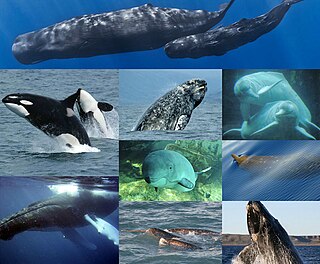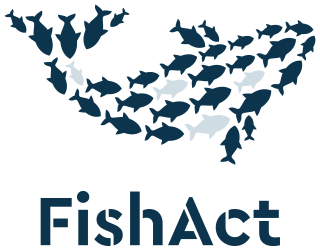Related Research Articles

Cetacea is an infraorder of aquatic mammals belonging to the order Artiodactyla that includes whales, dolphins, and porpoises. Key characteristics are their fully aquatic lifestyle, streamlined body shape, often large size and exclusively carnivorous diet. They propel themselves through the water with powerful up-and-down movement of their tail which ends in a paddle-like fluke, using their flipper-shaped forelimbs to maneuver.

The great white shark, also known as the white shark, white pointer, or simply great white, is a species of large mackerel shark which can be found in the coastal surface waters of all the major oceans. It is the only known surviving species of its genus Carcharodon. The great white shark is notable for its size, with the largest preserved female specimen measuring 5.83 m (19.1 ft) in length and around 2,000 kg (4,410 lb) in weight at maturity. However, most are smaller; males measure 3.4 to 4.0 m, and females measure 4.6 to 4.9 m on average. According to a 2014 study, the lifespan of great white sharks is estimated to be as long as 70 years or more, well above previous estimates, making it one of the longest lived cartilaginous fishes currently known. According to the same study, male great white sharks take 26 years to reach sexual maturity, while the females take 33 years to be ready to produce offspring. Great white sharks can swim at speeds of 25 km/h (16 mph) for short bursts and to depths of 1,200 m (3,900 ft).

Sowerby's beaked whale, also known as the North Atlantic or North Sea beaked whale, is a species of toothed whale. It was the first mesoplodont whale to be described. James Sowerby, an English naturalist and artist, first described the species in 1804 from a skull obtained from a male that had stranded in the Moray Firth, Scotland, in 1800. He named it bidens, which derives from the two teeth present in the jaw, now known to be a very common feature among the genus.

Gray's beaked whale, sometimes known as Haast's beaked whale, the scamperdown whale, or the southern beaked whale, is one of the better-known members of the genus Mesoplodon. This species is fairly gregarious and strands relatively frequently for a beaked whale. In the Māori language, this species is called hakurā or iheihe.

The strap-toothed beaked whale, also known as Layard's beaked whale, is one of the largest members of the mesoplodont genus, growing to 6.2 m (20 ft) in length and reaching up to 1,300 kg (2,900 lb). The common and scientific name was given in honor of Edgar Leopold Layard, the curator of the South African Museum, who prepared drawings of a skull and sent them to the British taxonomist John Edward Gray, who described the species in 1865.

The false killer whale is a species of oceanic dolphin that is the only extant representative of the genus Pseudorca. It is found in oceans worldwide but mainly in tropical regions. It was first described in 1846 as a species of porpoise based on a skull, which was revised when the first carcasses were observed in 1861. The name "false killer whale" comes from having a skull similar to the orca, or killer whale.

The pygmy killer whale is a poorly known and rarely seen oceanic dolphin. It is the only species in the genus Feresa. It derives its common name from sharing some physical characteristics with the orca also known as the killer whale. It is the smallest cetacean species that has the word "whale" in its common name. Although the species has been known to be extremely aggressive in captivity, this aggressive behavior has not been observed in the wild.

The melon-headed whale, also known less commonly as the electra dolphin, little killer whale, or many-toothed blackfish, is a toothed whale of the oceanic dolphin family (Delphinidae). The common name is derived from the head shape. Melon-headed whales are widely distributed throughout deep tropical and subtropical waters worldwide, but they are rarely encountered at sea. They are found near shore mostly around oceanic islands, such as Hawaii, French Polynesia, and the Philippines.

Right whale dolphins are cetaceans belonging to the genus Lissodelphis. It contains the northern right whale dolphin and the southern right whale dolphin. These cetaceans are predominantly black, white beneath, and some of the few without a dorsal fin or ridge. They are smaller members of the delphinid family, oceanic dolphins, and very slender. Despite scientists being long acquainted with the species, little is known about them in terms of life history and behaviour.

The southern right whale dolphin is a small and slender species of cetacean, found in cool waters of the Southern Hemisphere. It is one of two species of right whale dolphin. This genus is characterized by the lack of a dorsal fin. The other species, the northern right whale dolphin, is found in deep oceans of the Northern Hemisphere and has a different pigmentation pattern than the southern right whale dolphin.

The Pacific white-sided dolphin, also known as the hookfin porpoise, is an active dolphin found in the cool or temperate waters of the North Pacific Ocean.

The dwarf sperm whale is a sperm whale that inhabits temperate and tropical oceans worldwide, in particular continental shelves and slopes. It was first described by biologist Richard Owen in 1866, based on illustrations by naturalist Sir Walter Elliot. The species was considered to be synonymous with the pygmy sperm whale from 1878 until 1998. The dwarf sperm whale is a small whale, 2 to 2.7 m and 136 to 272 kg, that has a grey coloration, square head, small jaw, and robust body. Its appearance is very similar to the pygmy sperm whale, distinguished mainly by the position of the dorsal fin on the body–nearer the middle in the dwarf sperm whale and nearer the tail in the other.

Otodus megalodon, commonly known as megalodon, is an extinct species of giant mackerel shark that lived approximately 23 to 3.6 million years ago (Mya), from the Early Miocene to the Pliocene epochs. O. megalodon was formerly thought to be a member of the family Lamnidae and a close relative of the great white shark, but has been reclassified into the extinct family Otodontidae, which diverged from the great white shark during the Early Cretaceous.

A shark net is a submerged section of gillnets placed at beaches designed to intercept large marine animals including sharks, with the aim to reduce the likelihood of shark attacks on swimmers. Shark nets used are gillnets which is a wall of netting that hangs in the water and captures the marine animals by entanglement, however only around 10% of catch is the intended target shark species. The nets in Queensland, Australia, are typically 186m long, set at a depth of 6m, have a mesh size of 500mm and are designed to catch sharks longer than 2m in length. The nets in New South Wales, Australia, are typically 150m long, set on the sea floor, extending approximately 6m up the water column, are designed to catch sharks longer than 2m in length. Shark nets do not create an exclusion zone between sharks and humans, and are not to be confused with shark barriers.

Cetacean stranding, commonly known as beaching, is a phenomenon in which whales and dolphins strand themselves on land, usually on a beach. Beached whales often die due to dehydration, collapsing under their own weight, or drowning when high tide covers the blowhole. Cetacean stranding has occurred since before recorded history.

Cetacean bycatch is the accidental capture of non-target cetacean species such as dolphins, porpoises, and whales by fisheries. Bycatch can be caused by entanglement in fishing nets and lines, or direct capture by hooks or in trawl nets.

Marine conservation activism is the efforts of non-governmental organizations and individuals to bring about social and political change in the area of marine conservation. Marine conservation is properly conceived as a set of management strategies for the protection and preservation of ecosystems in oceans and seas. Activists raise public awareness and support for conservation, while pushing governments and corporations to practice sound ocean management, create conservation policy, and enforce existing laws and policy through effective regulation. There are many different kinds of organizations and agencies that work toward these common goals. They all are a part of the growing movement that is ocean conservation. These organizations fight for many causes including stopping pollution, overfishing, whaling and by-catching, and supporting marine protected areas.
Enrico Gennari is an Italian marine biologist who specialises in the study of the great white shark.

FishAct is an international marine conservation and activism organisation based in Amsterdam, Netherlands. Its name was changed in 2018 to FishAct. FishAct's stated mission is to "end the industrial overfishing of the oceans" and to "empower individuals to get actively involved in building grassroots citizen-led conservation communities". The non-governmental organisation was founded in 2010 and has active local chapters in Germany and the United Kingdom. To achieve its goals, the organisation uses a combination of investigation, education, and non-violent direct-action. Campaigns have included gathering support for the release of captive cetaceans, actions against dolphin drive hunts and campaigning to end overfishing of the endangered bluefin tuna in the Mediterranean Sea.

A drift whale is a cetacean mammal that has died at sea and floated into shore. This is in contrast to a beached or stranded whale, which reaches land alive and may die there or regain safety in the ocean. Most cetaceans that die, from natural causes or predators, do not wind up on land; most die far offshore and sink deep to become novel ecological zones known as whale falls. Some species that wash ashore are scientifically dolphins, i.e. members of the family Delphinidae, but for ease of use, this article treats them all as "drift whales". For example, one species notorious for mass strandings is the pilot whale, also known as "blackfish", which is taxonomically a dolphin.
References
- ↑ "Sustainable Development and Environment | The Dolphin Action Protection Group". Enviropaedia.com. Retrieved 4 May 2010.
- ↑ Frankel, Bruce (18 July 1991). "Oceans' protectors decry `walls of death'". USA Today. Retrieved 4 May 2010.
- ↑ Bernvi, D.C. (2014). Vithajen Carcharodon carcharias. Caracal Publishing. ISBN 978-9197583398. 840 pp.
- ↑ "Beached Pilot Whales Euthanized - Western Cape, South Africa - CNN iReport". Ireport.com. 30 May 2009. Retrieved 4 May 2010.
- ↑ Bernvi, D.C. (2014). Vithajen Carcharodon carcharias. Caracal Publishing. ISBN 978-9197583398. 840 pp.
- ↑ Bernvi, D.C. (2014). Vithajen Carcharodon carcharias. Caracal Publishing. ISBN 978-9197583398. 840 pp.